How to Fix my Broken Landscape Lighting Fixtures
Landscape lighting does so much to accentuate your yard’s beauty at night. That is until your fixtures start breaking. Today we are going to discuss how different low voltage landscape lighting fixtures can go bad and why they break.
Sometime repairs to a broken fixture can be a simple fix! But other times, even if they can be fixed, you may still be asking yourself why all these fixtures keep breaking in the first place.
Without any further ado, Lets get into it!
Broken ground stakes
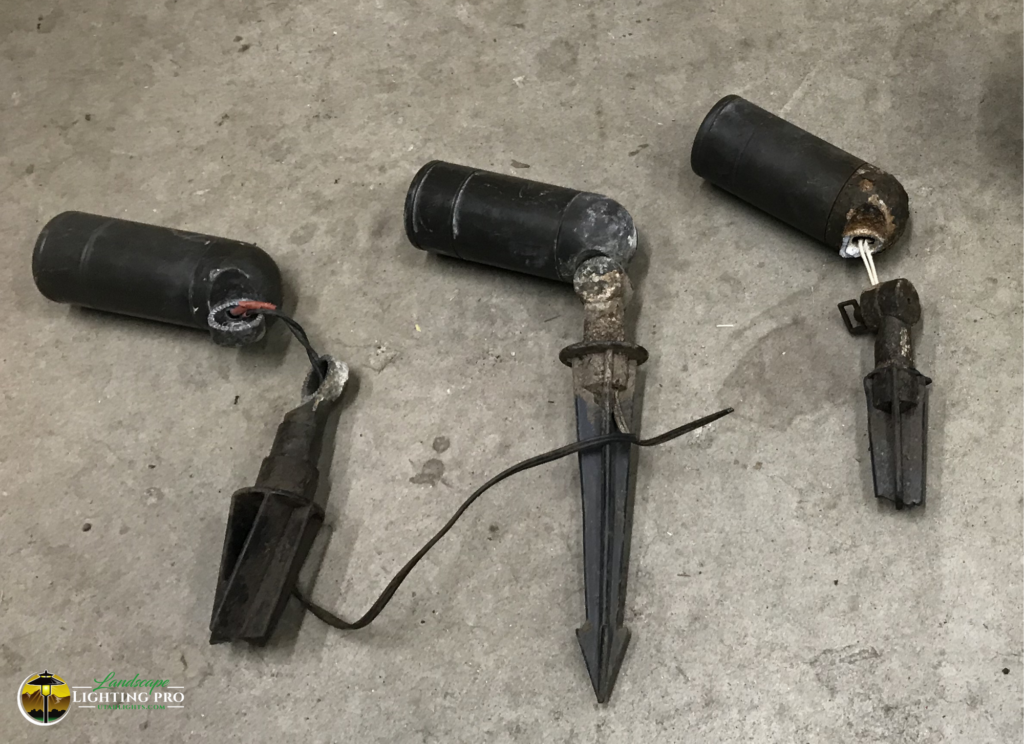
Broken ground stakes are probably the most common problem people encounter with their landscape lighting system.
To be clear, the ground stake is the part attached to the bottom of your fixture that sticks into the ground, the pointy end that is burred down where no one can see it.
Ground stakes break for all sorts of reasons: people might hit a path light with a snow shovel while clearing the walkway, the neighbor’s dog could nock over a light while running across the front yard, or your young teenager – equipped with their new drivers license – somehow plowed right over the path lights lining the driveway. These things happen…
There are two common ways ground stakes break. They either break cleanly with a crack running through them or they strip the threads that attach to the fixture when fixture becomes dislodged. In either case you’ll have to replace the ground stake. This repair is simple because all you need is a new replacement.
However, never try to screw a fixture back down onto a broken ground stake. A busted ground stake can cause more problems to your fixture if you attempt to reuse it. I’ve seen many good intentioned clients of ours do this because they didn’t realize the problem they were creating.
When they see the fixture laying next to the ground stake, they try to reattach the two by spinning the fixture back into the ground stake still buried in the earth. But if the ground stake is cracked or if the threads are stripped, the fixture will just keep spinning and never find any solid perches.
The continued spinning eventually will twist the wires tight until they either break, fray, or rip themselves out of the socket. Then not only is the ground stake broken, the fixture also stops working.
Should you choose brass over a plastic stake?
If you don’t want to deal with flimsy plastic ground stakes that break more easily, there are heavy-duty brass alternatives available.
I’ve heard it said by some landscape contractors that they prefer plastic ground stakes over brass because if the fixture is stuck by something, then at least the force of the blow will break the plastic ground stake instead of the fixture.
However, I disagree, there is a flaw in this line of thinking. I say if there is any worry that the fixture could break because it used a brass stake, then it must not be a very high quality fixture.
The landscape is a harsh environment. The fixtures we put in it need to be robust enough to be able to stand up to the test of time. A quality fixture that is built solid will only be complimented well when paired with an equally strong brass ground stake.
Pathlight with broken glass
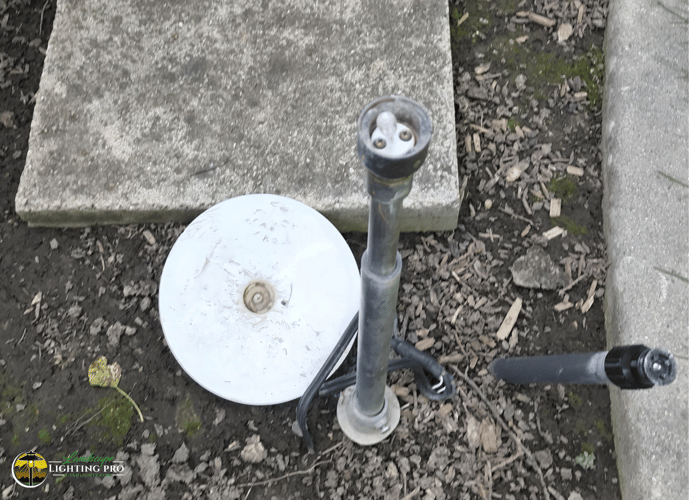
The top hat on a traditional path light is meant to block any glare from hitting people’s eyes and to help project the fixture’s light source down onto the ground where it is needed.
One of the weakest points on a traditional path light fixture is the glass connecting the top hat to the post. If the top hat is struck or bumped, its possible for the glass to break.
The repair for a broken lens requires a new glass lens and some kind of epoxy or resin to reattach the post, glass lens, and top hat all back together.
This can require carefully cleaning out and removing the old broken lens. Be mindful not to cut yourself on broken glass.
Keep in mind that replacing the glass lens may not stop the lens from breaking again. Take a close look at any broken path light lenses you have and ask yourself why they broke in the first place. Sometimes the lighting design, where the lights are located, can be part of the reason why these lights are breaking.
Are your path lights located next to a place where opening car doors could be a hazard? Are there path lights in your backyard too close to where your kids like to kick the soccer ball around?
Its important to think about how your outdoor space is used and what kind of abuse your outdoor fixtures might incur in that area.
Is there a way to keep my fixtures where they are without worrying that they might brake?
In most cases, absolutely!
You may just need a fixture that is up to the challenge.
There are heavy duty path lights that are purposefully engineered to prevent glass lenses from breaking if the fixture takes a hit. These fixtures use brass rods that attach the top hat to the post rather than a glass lens.
The right path light that is engineered with thickly gaged metal made from nonferrous materials, a sturdy brass ground stake, and rods attaching the top hat to the post are virtually bullet proof.
Fixture filling with water
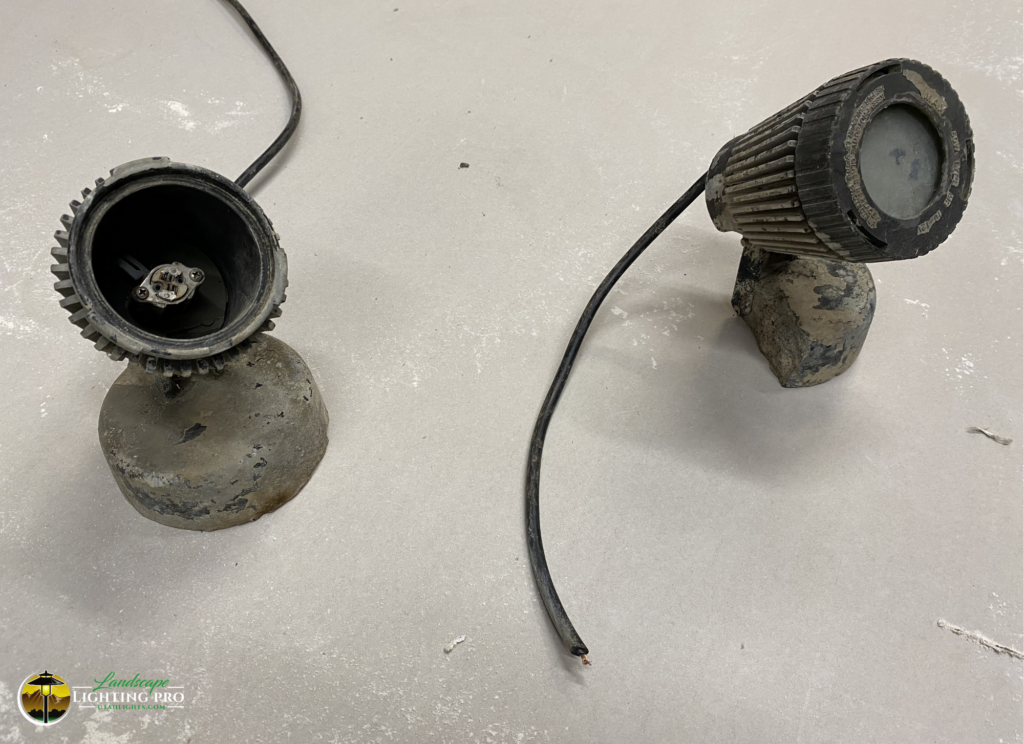
Is your fixture filling with water? It could be a bad gasket.
The internal components in your landscape lighting fixtures need to stay dry. Water and electrical do not mix: especially when it comes to LED. A fixture that leaks is a fixture that will fail. Often times the solution to repairing a leaky fixture is replacing the gasket.
The gasket is a rubber O-ring that fits over the fixture so that when the components are all pieced together, there is a barrier to help keep the moisture out.
Gaskets can wear out over time.
Normal wear and tear can cause the gaskets to fray or break. If this happens then the gasket will need to be replaced. To check, open up your fixture and take a close look at the rubber gasket wrapped around the cylinder, does it look worn or damaged? Is the gasket even still there?
Checking the gasket is the first step in troubleshooting why your fixture might be leaking.
The second step is looking at the seal on the glass lens. If a directional up light has a bad lens that cracked or is not sealed to the fixture well, it will inevitable allow water to get inside.
If your experiencing multiple fixtures leaking. That could be a sign that there is a defect with them for so many to fail. On the other hand, a bunch of leaking fixtures could be an indication that the fixtures were not built to handle water well.
Are the fixtures built from composite (plastic)? Composite fixtures don’t handle temperature fluctuations very well. Even if they worked when they were first put in, over time composite fixtures can become brittle or warped.
In the end, repairing a leaking fixtures can be a simple fix. But if your experiencing multiple fixtures leaking, this could be an indication that it might be time to upgrade to something that can handle the outdoor environment better.
Broken, cracked, bent, or smashed neck / housing
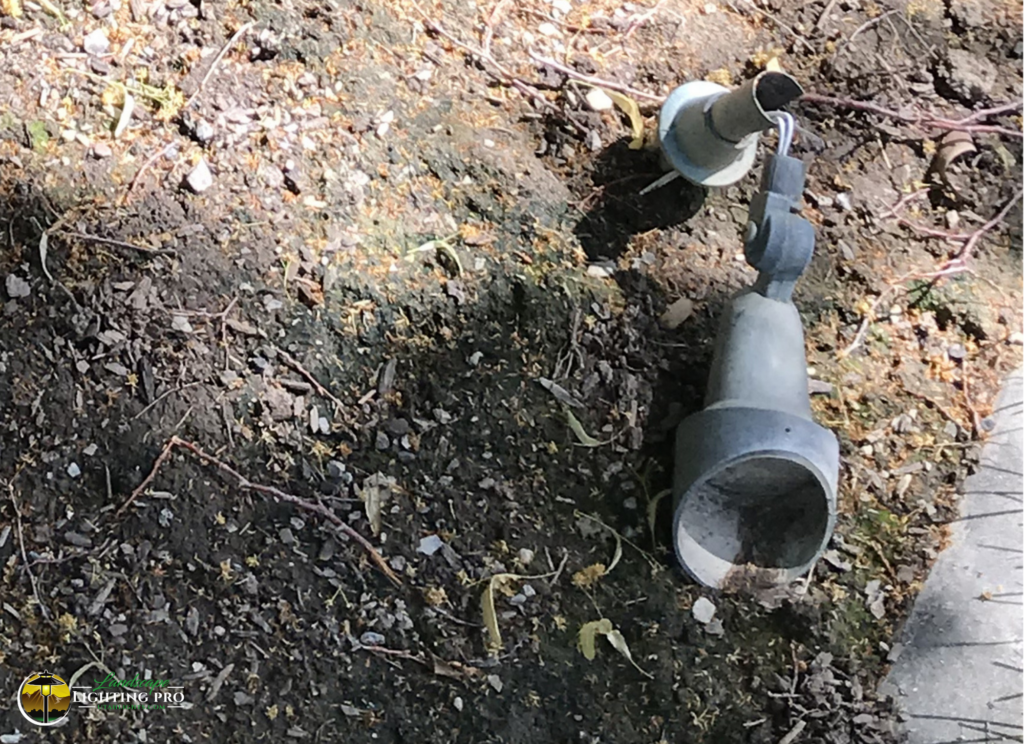
Unfortunately, if a fixture breaks at the neck or in a place that is integral, there usually isn’t much you can do.
While lots of DIY home repair projects can be tackled with duct tape and desperation, an utterly busted fixture usually isn’t one of them.
Even if you do manage to Frankenstein the poor thing back together, it will likely continue having problems. A broken fixture is a broken fixture. It will need to be replaced.
I know I sound like a broken record, but listen: ask yourself why the fixture broke.
Is the fixture a heavy duty piece of engineering, or was it built from low grade brass, aluminum, or tin metal? Was the metal that made up the fixtures housing a smaller or thicker gage? Does it seem like the fixture should have stood up better than it did?
Your lighting system is only as good as its fixtures, design, and engineering. If your fixtures are always having problems, then it sounds like you may need to consider a different fixture better suited to your yard’s needs.
Fixture sockets can go bad
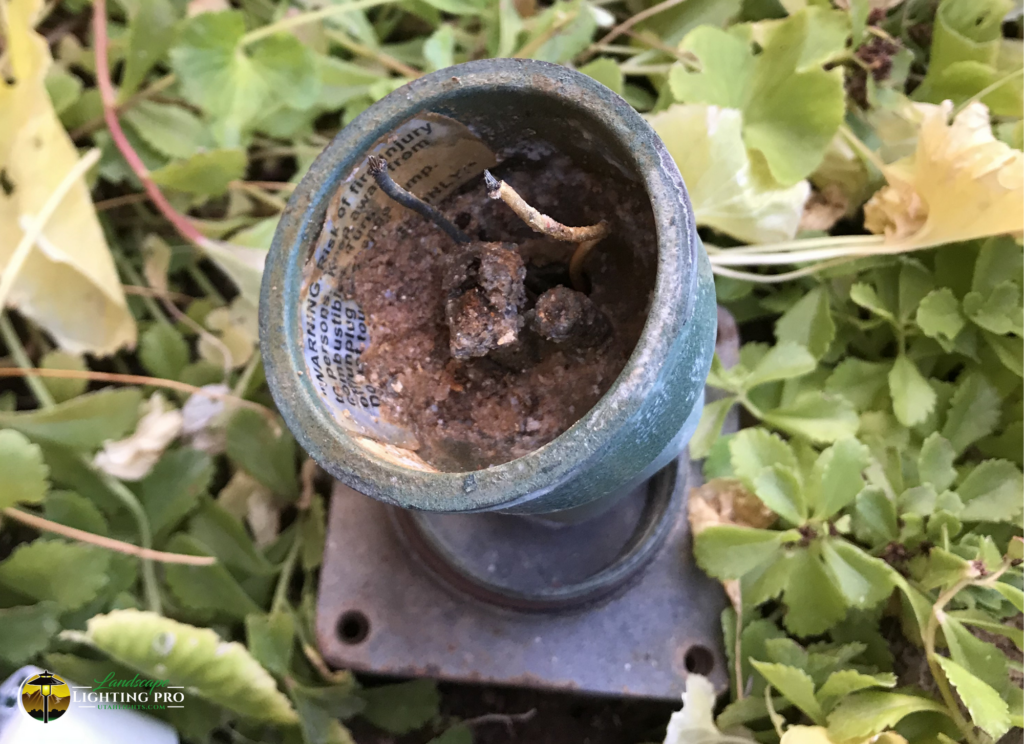
Many landscape fixtures share a similar internal component: namely, most fixtures have a socket.
The socket is the part of the fixture where the light bulb plugs in.
If one your fixtures has stopped working, you can try replacing the light bulb first. If you’ve tried this and the new light bulb doesn’t kick on, and all the other fixtures in the landscape seem to be fine, its possible you have a bad socket.
To see if your socket has power or not, try plugging in a new bulb. Another, more precise, way to test your socket can be preformed with the help of a voltage meter. A voltage meter can help you figure out if your socket is getting zero voltage, or just not enough voltage to power the bulb.
To learn more about voltage meters and what they are used for when troubleshoot landscape lighting systems, click here.
It is possible that power isn’t getting to the socket for some other reason, but you can usually tell if a socket has gone bad by just looking closely for certain problems.
Here are some things to watch for:
- Is the fixture filled with water or rust? Moisture is the bane of electrical components. A corroded socket can’t make good electrical contact with the bulb. In some cases, a socket’s metal components can completely corrode away if left in a wet environment for too long. A corroded socket needs to be replaced.
- Does the socket still have wires attached at the back? The wires sticking out the bottom of the fixtures are attached to the socket inside. If these wires are tugged or if the fixture is nocked over, the wires can be pulled free from the socket. If this happens, the wires cannot be reattached to the socket and a replacement will be remedied.
- Is there a spark, smoke, or heat? While its unlikely, your socket could be damaged. If the two prongs inside a typical landscape fixture socket are coming into contact with one another, this can cause a short that will trip the entire system. The truth: if this is happening, your lighting system’s symptoms will be very difficult to troubleshoot and identify. If you do notice heat of smoke, unplug your transformer immediately and call a professional landscape lighting service company.
A poorly designed/engineered fixture will continue giving you problems even if you repair the fixture or address the issue when you find it.
For example, if the socket is corroded, replacing it will not solve your problem. The corrosion was caused because the fixture allowed water to get inside.
If multiple fixtures in your lighting system are giving you moisture problems, then you know there is a serious flaw in the fixture’s design. Simply put, quality landscape lighting fixtures very rarely experience moisture problems.
The hard truth about outdoor lighting
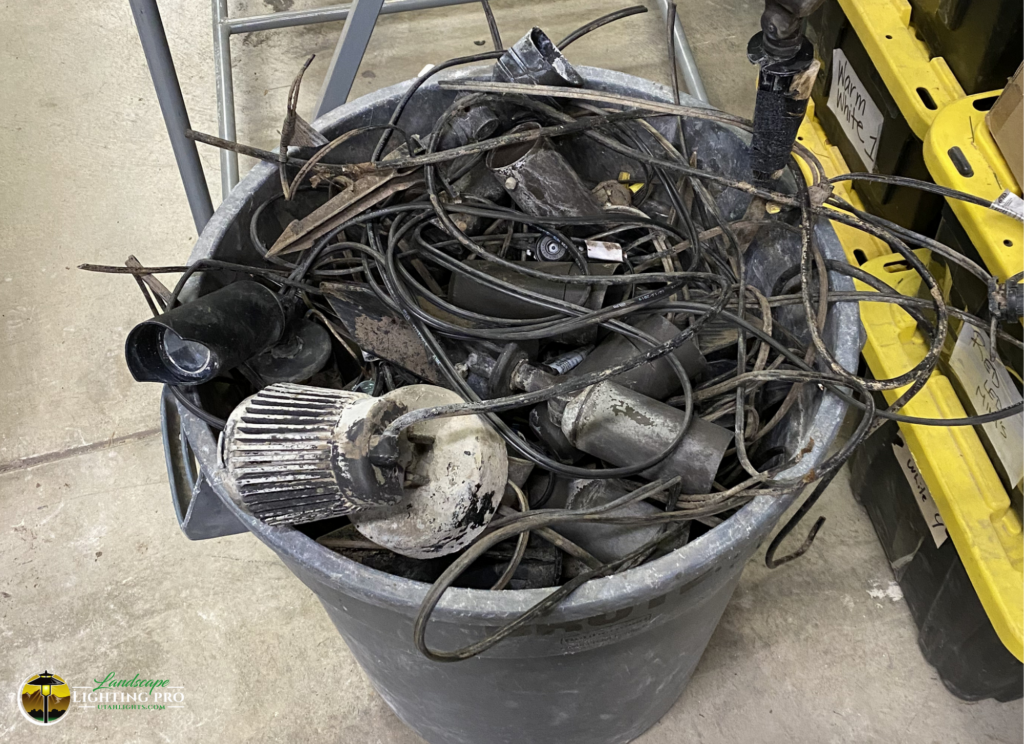
Over the years we’ve seen just about everything that can go wrong with a landscape lighting system. The truth is repair made to a poorly built system with lower quality fixtures will continue having lots of problems down the road.
When it all comes down to brass tax, you just want your lights to work. And I sympathize with anyone whose fixtures are failing and giving them heartburn: outdoor fixtures should be able to contend with wet environments caused by irrigation, rain, snow, etc.; landscape lighting fixtures should be built so that they are able to take a reasonable hit and still work.
There are many great fixtures being built by reputable manufacturers. These solid products are built to last a lifetime. Its one of the reasons why our company started designing and having our fixtures built for us the way we want them to be built. However, the dilemma many run into is the flood of sub-par landscape lighting products on the market. Its overwhelming to try going online to shop for lights.
Be cautious when selecting fixtures. Do your homework to insure you’re getting the best value for your money.
Need help with landscape lighting replacement or repairs?
If you are here looking to learn how to repair your broken lights, you might already have a system that you are not interested in replacing right away. That’s fine! Take advantage of this time to do your research so that when the time does comes to upgrade your lights, you’ll be ready to make an informed decision and have a new system that will last a lifetime.
If you need a new landscape lighting system but aren’t sure where to start, why not get a landscape lighting design company involved? This too can be a challenge when you aren’t sure who to hire. Luckily, we have a free guide meant to help you hire the right professional for your project! Just click here and you’ll soon be ready to meet with a designer who can help you with your lighting project.
Salt Lake City (Midvale)
801-440-7647
St. George
435-932-6627
©2025 Landscape Lighting Pro
Privacy Policy
Cookie Policy